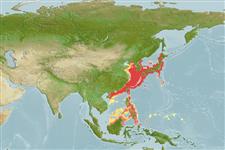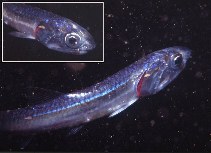添加你自己的观测位置在 Fish Watcher
| Native range | All suitable habitat | Point map | Year 2050 |

|
| This map was computer-generated and has not yet been reviewed. |
| Engraulis japonicus AquaMaps Data sources: GBIF OBIS |
上传你的 图片 和 影像
Pictures | 谷歌图片Engraulis japonicus
Picture by Zsilavecz, G.
Pictures | 谷歌图片Engraulis japonicus
Picture by Zsilavecz, G.
China country information
Common names:
姑仔, 姑仔, 日本鯷
Occurrence: native
Salinity: marine
Abundance: | Ref:
Importance: highly commercial | Ref: FAO, 1994
Aquaculture: | Ref:
Regulations: | Ref:
Uses: no uses
Comments: Known from Bohai in Liaoning Province (Ref. 47439) and from Yantai City and Qingdao City in Shandong Province (Ref. 47439). Also Ref. 559, 42692, 117610.
National Checklist:
Country Information: https://www.cia.gov/library/publications/resources/the-world-factbook/geos/ch.html
National Fisheries Authority:
Occurrences: Occurrences Point map
Main Ref: Whitehead, P.J.P., G.J. Nelson and T. Wongratana, 1988
National Database:
Occurrence: native
Salinity: marine
Abundance: | Ref:
Importance: highly commercial | Ref: FAO, 1994
Aquaculture: | Ref:
Regulations: | Ref:
Uses: no uses
Comments: Known from Bohai in Liaoning Province (Ref. 47439) and from Yantai City and Qingdao City in Shandong Province (Ref. 47439). Also Ref. 559, 42692, 117610.
National Checklist:
Country Information: https://www.cia.gov/library/publications/resources/the-world-factbook/geos/ch.html
National Fisheries Authority:
Occurrences: Occurrences Point map
Main Ref: Whitehead, P.J.P., G.J. Nelson and T. Wongratana, 1988
National Database:
Common names from other countries
分类 / Names 俗名 | 同种异名 | Catalog of Fishes(属, 种) | ITIS | CoL | WoRMS | Cloffa
Teleostei > Clupeiformes (Herrings) 鯡目 (Herrings) > Engraulidae (Anchovies) 鯷科 (Anchovies) > Engraulinae
Etymology: Engraulis: Greek, eggraulis, -eos = anchovy (Ref. 45335).
More on authors: Temminck & Schlegel.
Etymology: Engraulis: Greek, eggraulis, -eos = anchovy (Ref. 45335).
More on authors: Temminck & Schlegel.
Environment: milieu / climate zone / depth range / distribution range 生态学
海洋; 海洋洄游的 (Ref. 51243); 深度上下限 0 - 400 m (Ref. 50550). 溫帶; 8°C - 30°C (Ref. 56557); 49°N - 2°N, 105°E - 155°E (Ref. 54432)
分布 国家 | FAO区域 | 生态系 | 标本纪录 | Point map | 简介 | Faunafri
Western Pacific: southern Sakhalin Islands, Sea of Japan and Pacific coasts of Japan, and south to almost Canton/Taiwan; rare records (seems to represent stray fishes) off the coasts of Luzon and Western Mindanao, Philippines and from Manado and Ujung Pandang, Sulawesi, Indonesia (Ref. 189).
西太平洋: 南方的薩哈林島, 日本海與日本的太平洋海岸, 而且幾乎南至廣東/台灣; 稀有的記錄 (似乎代表迷途的魚) 外海的呂宋島與西方菲律賓民答那峨的海岸與從 Manado 與 Ujung Pandang ,印尼蘇拉威西.(參考文獻 189)
西太平洋: 南方的薩哈林島, 日本海與日本的太平洋海岸, 而且幾乎南至廣東/台灣; 稀有的記錄 (似乎代表迷途的魚) 外海的呂宋島與西方菲律賓民答那峨的海岸與從 Manado 與 Ujung Pandang ,印尼蘇拉威西.(參考文獻 189)
Length at first maturity / 大小 / 重量 / 年龄
Maturity: Lm 10.5, range 10 - 11 cm
Max length : 18.0 cm TL 雄鱼/尚未辨别雌雄; (Ref. 56527); common length : 14.0 cm TL 雄鱼/尚未辨别雌雄; (Ref. 56527); 最大体重: 45.00 g (Ref. 56527); 最大年龄: 4 年 (Ref. 56527)
Max length : 18.0 cm TL 雄鱼/尚未辨别雌雄; (Ref. 56527); common length : 14.0 cm TL 雄鱼/尚未辨别雌雄; (Ref. 56527); 最大体重: 45.00 g (Ref. 56527); 最大年龄: 4 年 (Ref. 56527)
简单描述 检索表 | 型态特徵 | 形态测量图
背棘 (总数) : 0; 背的软条 (总数) : 12 - 14; 臀棘: 0; 臀鳍软条: 13 - 18. Differs very little from the European anchovy (see E. encrasicolus) and can be identified from that description. Of other anchovies found in the southern part of its distribution, only species of Encrasicholina and Stolephorus are of similar appearance, but all have small spine-like pre-pelvic scutes (usually 2 to 7 scutes). Thryssa have compressed bodies and a keel of scutes along belly.
与欧洲的 鱼 (见 E. encrasicolus) 差异很小而且能从那描述被鉴定。 其他 鱼发现于它的分布的南部了, Encrasicholina 的唯一种与 Stolephorus 是相似外表, 但是全部有小的像棘一样的前腹鳍鳞甲.(通常 2 到 7个鳞甲) Thryssa 有扁长形的身体,而且一个鳞甲的龙骨脊沿着腹面。
与欧洲的 鱼 (见 E. encrasicolus) 差异很小而且能从那描述被鉴定。 其他 鱼发现于它的分布的南部了, Encrasicholina 的唯一种与 Stolephorus 是相似外表, 但是全部有小的像棘一样的前腹鳍鳞甲.(通常 2 到 7个鳞甲) Thryssa 有扁长形的身体,而且一个鳞甲的龙骨脊沿着腹面。
Occurs in large schools near the surface, mainly in coastal waters but as far out as over 1,000 km from the shore. Tends to move more northward and inshore in spring and summer. Juveniles associate with drifting seaweed (Ref. 12114, 12115). Feeds on copepods, but also on other small crustaceans, molluscan larvae, fish eggs and larvae and diatoms. Marketed fresh and salted, processed into fishmeal and oil (Ref. 12484).
形成大群的鱼群接近水表面, 主要在沿岸水域但是远达超过 1,000 公里距离岸边。 在春天与夏天倾向移动较北方与沿海地区。 稚鱼与漂流的海草聚在一起。 (参考文献 12114,12115) 吃桡脚类的动物, 也捕食其他的小型甲壳动物,软件动物的幼生,鱼卵与仔鱼与硅藻。 在市场上销售新鲜而盐腌的, 加工成鱼浆或鱼油.(参考文献 12484)
形成大群的鱼群接近水表面, 主要在沿岸水域但是远达超过 1,000 公里距离岸边。 在春天与夏天倾向移动较北方与沿海地区。 稚鱼与漂流的海草聚在一起。 (参考文献 12114,12115) 吃桡脚类的动物, 也捕食其他的小型甲壳动物,软件动物的幼生,鱼卵与仔鱼与硅藻。 在市场上销售新鲜而盐腌的, 加工成鱼浆或鱼油.(参考文献 12484)
Life cycle and mating behavior 成熟度 | 繁殖 | 产卵场 | 卵 | 孕卵数 | 仔鱼
西太平洋: 南方的薩哈林島, 日本海與日本的太平洋海岸, 而且幾乎南至廣東/台灣; 稀有的記錄 (似乎代表迷途的魚) 外海的呂宋島與西方菲律賓民答那峨的海岸與從 Manado 與 Ujung Pandang ,印尼蘇拉威西.(參考文獻 189)
主要参考文献
Upload your references | 参考文献 | 合作者 | 合作者
Whitehead, P.J.P., G.J. Nelson and T. Wongratana, 1988. FAO Species Catalogue. Vol. 7. Clupeoid fishes of the world (Suborder Clupeoidei). An annotated and illustrated catalogue of the herrings, sardines, pilchards, sprats, shads, anchovies and wolf-herrings. FAO Fish. Synop. 125(7/2):305-579. Rome: FAO. (Ref. 189)
人类利用
渔业: 高经济性; 养殖: 商业性; 诱饵: usually
FAO(渔业: 产生, 物种外形; publication : search) | FishSource | 周边海洋
更多信息
Population dynamics
成长参数
Max. ages / sizes
Length-weight rel.
Length-length rel.
体长-频率
Mass conversion
入添量
丰度
成长参数
Max. ages / sizes
Length-weight rel.
Length-length rel.
体长-频率
Mass conversion
入添量
丰度
Anatomy
鳃区
Brain
Otolith
鳃区
Brain
Otolith
Physiology
Body composition
Nutrients
耗氧量
游泳类型
游泳速度
Visual pigments
Fish sound
Diseases & Parasites
Toxicity (LC50s)
Body composition
Nutrients
耗氧量
游泳类型
游泳速度
Visual pigments
Fish sound
Diseases & Parasites
Toxicity (LC50s)
工具
Bio-Quiz | E-book | 野外调查 | 检索表 | 长度- 频率 Wizard | 生活- 历史的工具 | 分布图 | Classification Tree
| Catch-MSY |
特别资料
下载 XML
网络资源
Aquatic Commons | BHL | Cloffa | BOLDSystems | Websites from users | 核实 FishWatcher | CISTI | Catalog of Fishes(属, 种) | DiscoverLife | ECOTOX | Faunafri | Fishtrace | GenBank(基因组, 核苷酸) | GloBI | GOBASE | | Google Books | Google Scholar | Google | IGFA World Record | MitoFish | 国家资料库 | Otolith Atlas of Taiwan Fishes | PubMed | Reef Life Survey | Scirus | SeaLifeBase | 树状分类阶层 | Wikipedia(转至, 搜寻) | World Records Freshwater Fishing | Zoobank | 动物学的记录
Estimates based on models
Preferred temperature (Ref. 115969): 8.1 - 23.3, mean 18.4 (based on 139 cells).
Phylogenetic diversity index (Ref. 82804): PD50 = 0.5020 [Uniqueness, from 0.5 = low to 2.0 = high].
Bayesian length-weight: a=0.00398 (0.00272 - 0.00583), b=3.10 (2.98 - 3.22), in cm Total Length, based on LWR estimates for this species & Genus-body shape (Ref. 93245).
营养阶层 (Ref. 69278): 3.1 ±0.1 se; based on diet studies.
回复力 (Ref. 120179): 高度, 族群倍增时间少于 15个月 (K=1.05; tm=1-2; tmax=3).
Prior r = 0.90, 95% CL = 0.60 - 1.36, Based on 3 full stock assessments.
Fishing Vulnerability (Ref. 59153): Low vulnerability (23 of 100).




